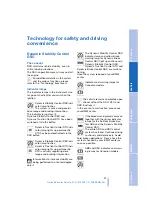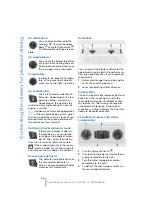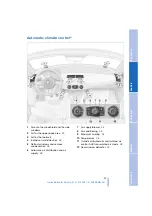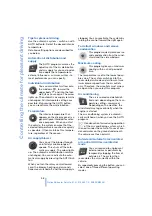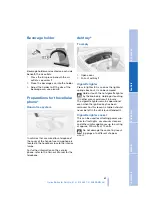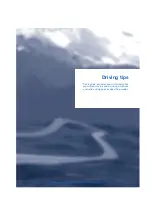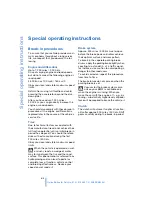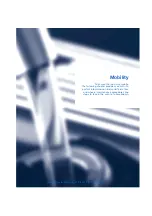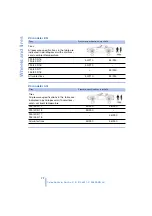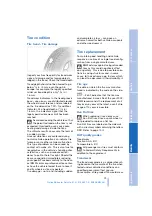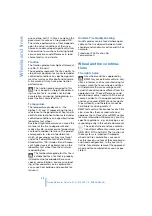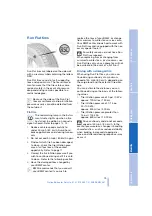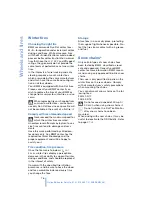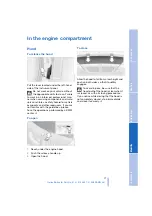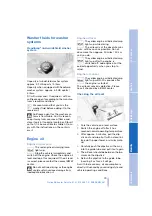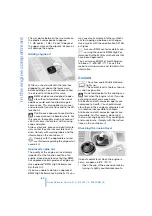
At a glance
Controls
Driving tips
Mobility
Reference
65
Driving notes
Parking the vehicle
Condensation forms in the air conditioner
system during operation, which then exits
under the vehicle. Traces of condensed
water on the ground underneath the vehi-
cle are thus normal.
Brakes
Do not drive with your foot resting on
the brake pedal. Even light but con-
sistent pedal pressure can lead to high
temperatures, brake wear and possibly
even brake failure.
Hydroplaning
When driving on wet or slushy roads,
reduce vehicle speed. If you do not, a
wedge of water may form between the tires
and the road surface. This phenomenon
can lead to partial or complete loss of trac-
tion, vehicle control and braking effective-
ness.
<
Driving through water
Do not drive through water on the
road if it is deeper than 1 ft / 30 cm,
and then only at walking speed. Otherwise,
the vehicle's engine, the electrical systems
and the transmission may be damaged.
<
High temperatures
High temperatures occur with every
vehicle equipped with a catalytic con-
verter. Heat shields are installed adjacent to
some sections of the exhaust system. Never
remove these shields; do not apply under-
coating to their surfaces. When driving,
standing at idle and parking the vehicle,
take care to avoid contact between the hot
exhaust system and flammable materials –
e.g. hay, leaves, grass, etc. Such contact
could lead to a fire, resulting in serious per-
sonal injury and property damage.
<
Brake system
The brake warning lamp lights up
although the parking brake is not
engaged: check the brake fluid
level. It is very important that you follow the
instructions on page
Disc brakes
Corrosion
Limited vehicle use, extended periods with
the vehicle parked or in storage, and oper-
ating conditions in which braking is
restricted to gentle, low-pressure applica-
tions will all increase the tendency for cor-
rosion to form on the rotors and contamina-
tion to accumulate on the brake pads. This
occurs because the minimal pressure
which must be exerted by the pads to clean
the rotors by brake applications is not
reached.
If the brake rotors are corroded, they will
tend to respond to braking with a pulsating
effect which even extended application will
fail to cure.
Wet roads
When driving in heavy rain and on wet
roads, it is useful to apply light pressure
to the brake pedal every few miles. Watch
traffic conditions to ensure that this maneu-
ver does not endanger other road users.
The heat generated in this process helps
dry the pads and rotors to ensure that your
brake system will respond with undimin-
ished efficiency when you need it.
Inclines
Extended or steep mountain descents
should be driven in the gear or drive posi-
tion in which only minimal periodic brake
application is required. This helps avoid
placing excessive loads on the brake sys-
tem. Observe the maximum allowable
engine speed when doing so; refer to
page
Do not coast with the clutch
depressed or with the transmission or
selector lever in Neutral. Do not coast with
Online Edition for Part-No. 01 41 0 156 897 - © 09/02 BMW AG
Содержание Z3 roadster 2.5i
Страница 1: ...Owner s Manual for Vehicle Contents A Z Online Edition for Part No 01 41 0 156 897 09 02 BMW AG ...
Страница 2: ...Online Edition for Part No 01 41 0 156 897 09 02 BMW AG ...
Страница 10: ...Online Edition for Part No 01 41 0 156 897 09 02 BMW AG ...
Страница 16: ...Online Edition for Part No 01 41 0 156 897 09 02 BMW AG ...
Страница 62: ...Online Edition for Part No 01 41 0 156 897 09 02 BMW AG ...
Страница 68: ...Online Edition for Part No 01 41 0 156 897 09 02 BMW AG ...
Страница 92: ...Online Edition for Part No 01 41 0 156 897 09 02 BMW AG ...
Страница 104: ...Everything from A Z 104 Online Edition for Part No 01 41 0 156 897 09 02 BMW AG ...

